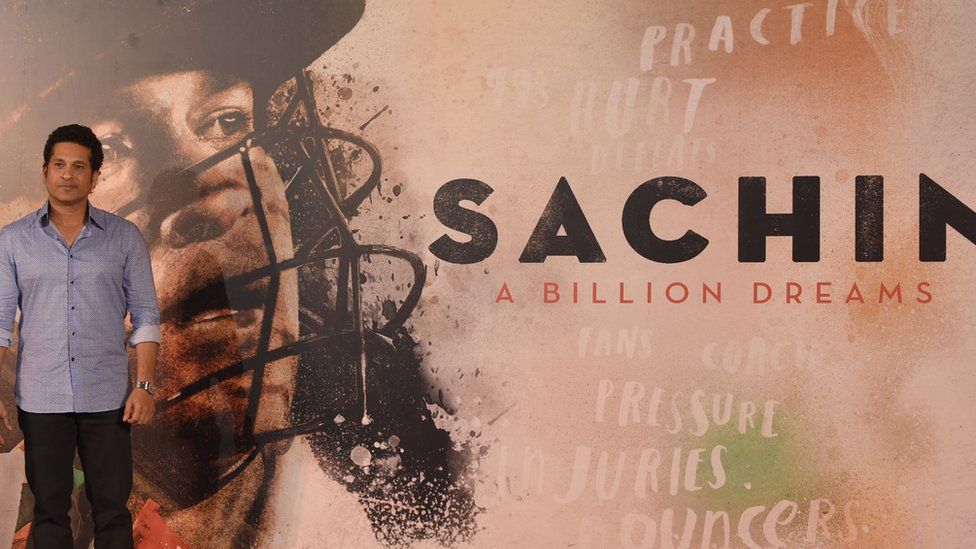Sachin Tendulkar, 'God of cricket', returns on celluloid
- Published

"Sachin Tendulkar is not an icon or a hero, he is an emotion."
This line from a new film on the life and career of the legendary cricketer very much sums up his stature among his fans.
He made millions teary-eyed in 2013 when he announced that his "life between 22 yards for 24 years had come to an end".
For his fans, the world as they knew it changed forever. Slowly, and rather reluctantly, they accepted that the "god of cricket" had decided to hang up his boots.
Three years later, the maestro is back - this time on cinema screens with his docudrama titled Sachin: A Billion Dreams.
The title seems befitting for a man who had the ability to make a billion people happy or sad just with a stroke.
People closely followed every run he scored and every word he spoke for almost a quarter of a century.
But this intense fan following seems to have caused problems for his film.
Critics point out that it offers very little that people already didn't know about him.
The film starts with scenes from his humble childhood home in Mumbai. It shows how disciplined he was as a school-level cricketer, and how India's 1983 World Cup victory fired his imagination to play for his country.
After showing recreated scenes from his childhood, the film moves to his life as a professional cricketer.
The legend made his debut in 1989 and cemented his place as the "most-loved cricketer" in India during the 1990s.
Tendulkar's rise also coincided with the country's economic liberalisation, and he became "the symbol" of a confident India trying to find its place in the world.
Tendulkar fact file
•1973: Born in Bombay (now Mumbai) on 24 April
•1989: Makes Test debut for India against Pakistan, aged 16
•1990: Scores first Test century, against England
•1998: Scores first double century for Mumbai against Australia
•2005: Passes Sunil Gavaskar's record of highest number of Test centuries
•2008: Becomes the highest run-scorer in Test cricket, passing West Indies' Brian Lara's mark of 11,953
•2010: Becomes the most capped player in Test history
•2011: Wins the World Cup with India
•2012: Scores his 100th international century in ODI v Bangladesh in March; retires from ODIs in December
•2013: Plays his 200th and final Test on his home ground in Mumbai
His story of a humble Mumbai boy becoming rich and famous through hard work resonated with many Indians.
British director James Erskine has documented this phase well with footage from his iconic innings.
The film also highlights how the cricketer's family supported him during times of crisis.
His wife, Anjali, left her medicine career to take care of the family while he concentrated on cricket.
"We accepted that cricket was his life," she says in the film.
The film also puts a spotlight on his short-lived and troublesome stint as India's captain. It doesn't go into the details, but mentions the apparent differences between him and former captain Mohammad Azharuddin while he was at the helm.
His struggles with injuries and bad form have been well documented. The film also mentions the infamous match-fixing scandal of 2000 that rocked Indian cricket to its foundations.
But it doesn't go into the details about what Tendulkar knew and why he chose to remain silent during the tumultuous period.
'Man behind the legend'
But for his fans, these seem to be minor points. The film has simply given them yet another opportunity to celebrate their hero.
It rides on nostalgia, and seeks to benefit from the endless love his fans have for him.
Every mention of his achievement was met with loud cheers and applause in the cinema hall. Every time he talked about his own vulnerabilities and pain, I could see some people quietly weeping.
That shows the emotional connection people share with him.
The film works best when he talks about his failures and successes, and what friends and family meant to him.
The rare footage of him spending time with his family manages to reveal the man behind the legend.
People also seemed happy to relive the memories of his epic partnerships and applauded whenever his former teammates like Saurav Ganguly and Harbhajan Singh made an appearance.
The film also highlights his agonising wait to win a World Cup for India. He came close to winning the coveted cup in 2003 but India lost to Australia in the finals.
He mentions how disappointed he was after the defeat and thought he was never going to lift the trophy.
But his wait ended in 2011 when India won. The film uses this moment beautifully, showing him running on the field like a schoolboy after captain MS Dhoni hit the winning runs.
It is hard not to feel the raw emotion of the moment, even though we have watched the footage many times before.
The film also explains how Tendulkar has inspired a generation of cricketers, including current captain Virat Kohli.
And that explains why Tendulkar is an "emotion" that Indians never want to forget.